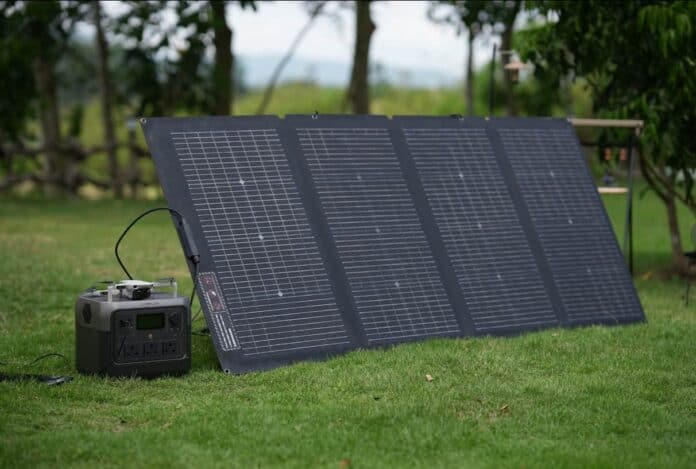Table of Contents
Portable power stations provide a simple, affordable way to harness the benefits of solar energy. These devices — also called solar generators — are all-in-one solutions for off-grid power. Leading edge models feature lithium-ion or LiFePO4 batteries, AC and USB outlets, and noise-free operation.
Best of all, you can recharge them using photovoltaic solar panels!
With EcoFlow, connecting a solar panel to a portable power station (PPS) couldn’t be easier. Just plug your solar PV panel directly into the PPS, and you have a solar generator ready to start capturing the sun’s energy.
There are a few other factors to consider, which we will explore below.
1. Choose a Compatible Solar Panel
Choosing a suitable PV panel is the first step toward charging your portable power station. Most solar panels are universally compatible with portable power stations, but you may have a few issues.
First, you must ensure that your panel does not overpower your solar generator. Some smaller power stations cannot receive current from higher voltage panels, and since photovoltaic panels and power stations operate at different currents, you’ll need to double-check the compatibility. Most premium models can accommodate higher input.
The connector on the PV panel also needs to match the input of your portable power station. There are a few popular connector types, including MC4, MC3, and T4.
When purchasing a portable power station, you can’t go wrong with adding on the manufacturer’s proprietary solar panels to ensure compatibility. Converters or adapters are often available for those who end up purchasing an incompatible panel.
2. Panel Placement
Think about your panel placement to get the most out of your panels. The summer sun will travel overhead and for more hours each day. This trajectory determines the best orientation and angle for your panels.
Angle your panels, so they are positioned perpendicular to the sun. As a general rule in South Africa, the optimal orientation is facing true north. The best angle will depend on your location.
If you have portable solar panels, you can adjust their angle until they directly face the sun. You may need to move your panels throughout the day as the sun travels across the sky. The more direct sunlight your solar panels receive, the more energy you’ll capture.
Some companies offer solar trackers that automatically follow the sun throughout the day, but manual adjustments also work fine — especially for portable applications.
3. Connect the Cables
The final step is simple: plug the panel into the portable power station’s input jack marked “DC In” or “Solar Input.” In some cases, such as a rooftop array, you may need a solar extension cable so that the panels can reach the unit.
If you are unsure which port to plug your PV panel into, view the instruction manual or contact the manufacturer for assistance.
Portable power stations feature solar charge controllers, which control the power sent from the photovoltaic panels. The charge controller will stop accepting power from the panels when the batteries reach full charge.
If using more than one panel, use a parallel cable connector to join the panels. Check the user manual of your PPS to ensure that your unit can handle the voltage and current that multiple panels will provide.
4. Safe Storage
If your solar generator is for emergencies, store it somewhere that you can easily access it in the case of a power outage.
Lithium-ion and LiFePO4 batteries are a safer alternative to lead acid batteries that used to be common in solar technology. They have a wide operating temperature range, so you can store them in cold sheds, for example, without worrying that it will negatively impact the battery.
That said, storing your solar generator in a dry location at room temperature is best for added safety and prevents other issues that may reduce the battery’s performance, such as water damage.
FAQs
Do Portable Power Stations Come With Solar Panels?
Solar panels do not usually come with portable power stations. Solar panels are typically sold separately so that the customer can pick the size and type of panel. However, you can get portable power stations with solar panels as package deals, such as the EcoFlow RIVER 2 with a 100W Portable Solar Panel.
Can You Connect More Than One Solar Panel to a Portable Power Station?
Most portable power stations only allow you to connect one solar panel at a time. Premium options like the EcoFlow DELTA Pro allow for more than one solar panel because of its wide voltage range of 11-150V.
Conclusion
A portable power station paired with solar panels allows consumers to capitalise on the benefits of renewable energy. If you’re considering making the switch, consider EcoFlow for your solar revolution.
